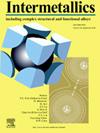Enhanced elasticity, fracture toughness and hardness in refractory TiZrHfNb high-entropy alloys by N- and O- doping engineering
IF 4.3
2区 材料科学
Q2 CHEMISTRY, PHYSICAL
引用次数: 0
Abstract
Nitrogen (N) and oxygen (O) doping have been considered as a new strategy to simultaneously improve the strength and fracture toughness/ductility of refractory TiZrHfNb high-entropy alloys (HEAs). Here, for the first time, we report the effects of N- and O- doping on the elasticity, fracture toughness and hardness of TiZrHfNb HEAs. Interestingly, the incorporation of N and/or O significantly enhances the elasticity and Vickers hardness of TiZrHfNb-based HEAs. More strikingly, the fracture toughness is enhanced by ∼33.3 %, and the hardness is simultaneously strengthened up to ∼10.4 % with the doping of 2.0 at% oxygen in TiZrHfNb-base HEAs. By contrast, the bulk modulus and shear rigidity show a monotonic increase with increasing N/O doping in (TiZrHfNb)100-x-yOxNy HEAs. The enhancement in bulk and shear moduli is more pronounced for N-doped HEAs compared to O-doped ones, which is attributed to the larger lattice distortions in the N-doped HEAs. These findings offer new insights into the design and preparation of novel refractory HEAs and enrich the understanding of the strengthening mechanisms in light element-doped HEAs.
求助全文
约1分钟内获得全文
求助全文
来源期刊

Intermetallics
工程技术-材料科学:综合
CiteScore
7.80
自引率
9.10%
发文量
291
审稿时长
37 days
期刊介绍:
This journal is a platform for publishing innovative research and overviews for advancing our understanding of the structure, property, and functionality of complex metallic alloys, including intermetallics, metallic glasses, and high entropy alloys.
The journal reports the science and engineering of metallic materials in the following aspects:
Theories and experiments which address the relationship between property and structure in all length scales.
Physical modeling and numerical simulations which provide a comprehensive understanding of experimental observations.
Stimulated methodologies to characterize the structure and chemistry of materials that correlate the properties.
Technological applications resulting from the understanding of property-structure relationship in materials.
Novel and cutting-edge results warranting rapid communication.
The journal also publishes special issues on selected topics and overviews by invitation only.
 求助内容:
求助内容: 应助结果提醒方式:
应助结果提醒方式:


